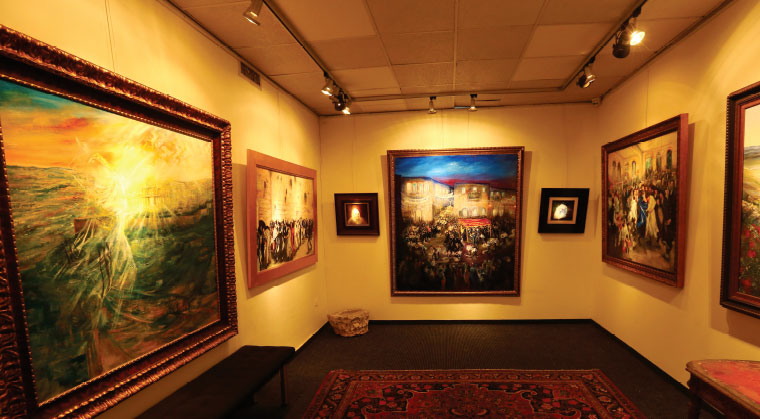Shades of Soul

In a tiny home in Meah Shearim, a nonagenarian woman paints breathtaking masterpieces that are acclaimed around the world. Huvy Elisha and her son Menachem share the strokes of destiny that colored her life

J
ust a few short kilometers separate Meah Shearim’s winding alleys from the tourist-filled, hotel-lined Rechov King David, but they are different universes. Those universes collide in a small art gallery, home to the exquisite paintings of Ahuva (Huvy) Elisha, nonagenarian resident of Meah Shearim, whose art is acclaimed around the world. But if art reflects life, perhaps this is not surprising — Huvy’s personality and life experiences are tinted with as many shades as her landscapes.
Gallery of Memories
Inside the gallery, I gaze at a large oil painting: a field of poppies, a haze of mauve mountains against the horizon. Huvy’s son, Menachem Elisha, has told me that Huvy’s childhood memories were seminal influences on her life’s work. She was born in the Bukharian quarter to Yerushalmi parents. When she was a young child, her parents moved to Czechoslovakia and then Austria, where her father had business interests, before settling in London, England.
I stare at the picture, trying to match the scene to the Devonshire countryside where Huvy was evacuated with her family. I draw a blank. Her son watches my puzzled face with glee. “You want to know where this is?”
“Yes.”
“That was my mother’s childhood playground. She would head out of the Bukharian Quarter and this expanse was her childhood playground. Meadows of poppies that led all the way up to Maalot Dafna.”
I look closer.
“When I tell people that this is Jerusalem, they don’t believe me. They haven’t seen anything like that here. But this is Jerusalem of the 1930s, the Jerusalem she loved from her childhood. The Jerusalem she returned to, later, with her family.”
I look around the gallery, stopping in front of a wedding scene: outdoor chuppah, joyous onlookers. “Ah, a classic Huvy image,” her son comments. Elisha explains that in addition to her paintings of nature, Huvy is famous for her scenes of Jewish life, and in particular, her paintings of weddings. One of her wedding scenes sold at an auction for over $100,000. These scenes reach back into Huvy’s stock of visual memories.
When the Elishas returned to live in Israel in the 1968, one of the first scenes Huvy witnessed was a simple wedding: chuppah held up by four men, a crowd of chassidim dancing and clapping, merrymakers lining the street. Vitality leaps out of the canvas — the joy of the newlyweds, the emotion of the crowd, the sense that for a moment, the world has stopped its journey and celebrates two souls joining as one. Perhaps it’s also a wink at her own personal history. In 1945, at age 17, Huvy married. “It was the first wedding to take place when the war was over,” Elisha says.
The impressionist-nature of the work means that as you look, the picture yields more secrets. I point to the fiddler at the side of the picture. “Ah, yes,” Elisha says. “You’ll find a violinist in all the wedding scenes.”
I press him for details. “When my mother was ten years old, her father gave her a violin. She loved playing. He was a quiet man, but she was very close to him. In England, my grandmother wanted my mother to study medicine and become a doctor. But her father pushed her towards art. I suppose the violin in each picture is a tribute to her father.”
Oops! We could not locate your form.












